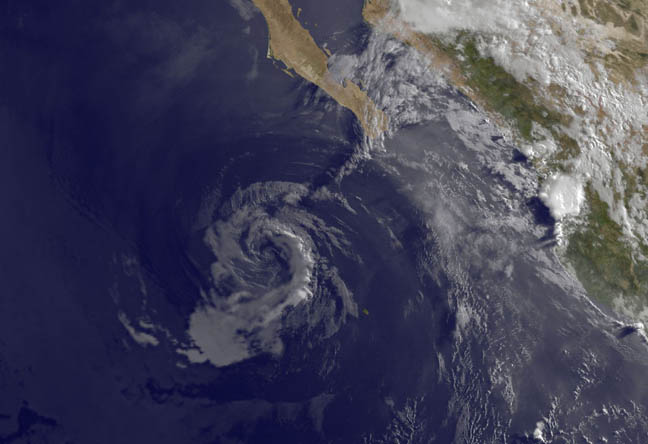A Satellite View: Former Hurricane Cristina Now a Ghost of Its Former Self

NOAA's GOES-West satellite captured this infrared image of Cristina as a remnant low pressure area on June 16 at 9:15 a.m. EDT. Image Credit: NASA/NOAA GOES Project
Convection is rising air that forms the thunderstorms that make up a tropical cyclone and when there is none, there are no thunderstorms to keep it going. That's exactly what happened to Cristina in the Eastern Pacific Ocean on Sunday, June 15.
At 11 a.m. EDT (8 a.m. PDT) on Sunday, June 15, Cristina had weakened to a tropical depression near latitude 20.1 north and longitude 113.3 west, about 290 miles (470 km) southwest of the southern tip of Baja California At that time the depression was moving toward the west-northwest near 6 mph (9 kph) and Cristina's maximum sustained winds had decreased to near 35 mph (55 kph).
Forecaster Brennan at the National Hurricane Center (NHC) noted that “Cristina continues to lack any deep convection, which is not surprising given the hostile environment of strong shear, cool waters and dry air.”
That hostile environment took its toll on Cristina early on June 16 when the NHC declared Cristina a remnant low pressure area. At 09:07 UTC (5:07 a.m. EDT), the post-tropical remnant low pressure area formerly known as Cristina was centered near 21 north latitude and 115 west longitude.
The remnant low had maximum sustained winds near 20 to 25 knots (23 to ~29 mph/37 to ~46 kph) and was generating seas to 8 feet (2.4 meters). As Cristina's remnants continue to dissipate, NHC forecasters expect wave heights to decrease.
Text credit: Rob Gutro
NASA's Goddard Space Flight Center
Media Contact
All latest news from the category: Earth Sciences
Earth Sciences (also referred to as Geosciences), which deals with basic issues surrounding our planet, plays a vital role in the area of energy and raw materials supply.
Earth Sciences comprises subjects such as geology, geography, geological informatics, paleontology, mineralogy, petrography, crystallography, geophysics, geodesy, glaciology, cartography, photogrammetry, meteorology and seismology, early-warning systems, earthquake research and polar research.
Newest articles

Economies take off with new airports
A global study by an SUTD researcher in collaboration with scientists from Japan explores the economic benefits of airport investment in emerging economies using nighttime satellite imagery. Be it for…

CAR T–cell immunotherapy targets
Pan-cancer analysis uncovers a new class of promising CAR T–cell immunotherapy targets. Scientists at St. Jude Children’s Research Hospital found 156 potential CAR targets across the brain and solid tumors,…

Stony coral tissue loss disease
… is shifting the ecological balance of Caribbean reefs. The outbreak of a deadly disease called stony coral tissue loss disease is destroying susceptible species of coral in the Caribbean…





















